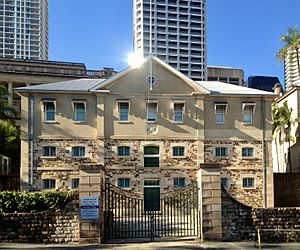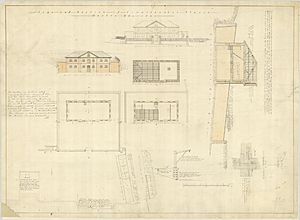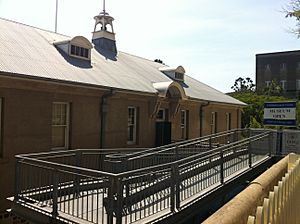Commissariat Store, Brisbane facts for kids
Quick facts for kids Commissariat Store, Brisbane |
|
|---|---|

Queen's Wharf Road facade of the Commissariat Store
|
|
| Location | 115–127 William Street, Brisbane City, City of Brisbane, Queensland, Australia |
| Design period | 1824–1841 (convict settlement) |
| Built | July 1828 – 1829, 1913 |
| Built for | Moreton Bay penal settlement |
| Restored | 1969, 1978–1981, 1998–2001 |
| Current use | Royal Historical Society of Queensland |
| Architect | William John Dumaresq |
| Architectural style(s) | Georgian |
| Owner | Queensland Government |
| Official name: Commissariat Store (former), Government Stores (1898–1923), State Stores Building (1923–1960), Commissariat Stores (former), Colonial Store (1860–1898) | |
| Type | state heritage (built) |
| Designated | 21 October 1992 |
| Reference no. | 600176 |
| Significant period | 1828–29, 1890, 1912–13 (fabric) 1829–1960 (historical) |
| Significant components | fence/wall – perimeter, store/s / storeroom / storehouse, wall/s – retaining, yard |
| Builders | Convict labour |
| Lua error in Module:Location_map at line 420: attempt to index field 'wikibase' (a nil value). | |
The Commissariat Store is a very old building in Brisbane City, Queensland, Australia. It is located at 115–127 William Street, near the Brisbane River. This building is special because it is one of the oldest buildings in Queensland and was built by convicts.
It was designed by William John Dumaresq and built between 1828 and 1913. Its main purpose was to store supplies for the Moreton Bay penal settlement. Today, it is known by several names, including Government Stores and Colonial Store. It was added to the Queensland Heritage Register in 1992.
This store is one of only two buildings left from the convict era in Queensland. It is also one of only four original commissariat buildings still standing in Australia. The Commissariat Store is the second oldest building in Queensland, built in 1829. The oldest is the Windmill from 1828. However, the Commissariat Store is the oldest building in Queensland that is still being used today. It houses a museum, a library, and spaces for events.
Contents
History of the Store
The Commissariat Store was built by convicts in 1828–1829. It was a two-storey building made of local stone. It was used to store food and other supplies near the Brisbane River. In 1913, a third storey made of brick was added. This made the building taller and gave it an entrance on William Street.
Building for the Penal Settlement
In 1823, Moreton Bay was chosen as a place for a new penal colony. This was for convicts from New South Wales who had committed more crimes. The goal was to control them better through hard work and strict rules. In 1824, the first convicts arrived at Redcliffe. But this spot was not good, so the settlement moved to a ridge overlooking the Brisbane River in 1825.
A "commissariat" was like a supply department for the colony. It managed getting and giving out important goods. The first store was a simple wooden building. In 1826, Captain Patrick Logan became the Commandant. He started building stronger structures from stone and brick, including the Commissariat Store. It was built near the river so goods could be easily loaded and unloaded from a wharf. This also helped keep important supplies like tools and food safe.
The store was designed by William John Dumaresq. His plans arrived from Sydney in 1828. The building was simple but strong, using local materials. Convicts did the heavy digging work. Skilled stonemasons built the walls. Retaining walls were also built around the store to hold back the earth.
The first convict colony in Australia started in New South Wales in 1788. Other convict stores were built in different places. Besides the Brisbane store, seven other convict-built Commissariat Stores still exist today:
- Hobart, Tasmania (1808–1810)
- Darlington Probation Station on Maria Island, Tasmania (1825)
- Oatlands, Tasmania (1827)
- Paterson Barracks Commissariat Store, Launceston, Tasmania (1828)
- Kingston and Arthur's Vale Historic Area, Norfolk Island (1835)
- Fremantle, Western Australia (1852)
- Guildford, Western Australia (1853–1854)
These old stores were built for the same purpose and have similar features. They were usually near water for easy transport. They looked strong and official, with simple Georgian and Regency styles.
The Brisbane store faced the river, showing its importance as the entry point to the colony. It even had the royal cypher of King George IV and the date 1829 on its river-facing side. The building was made from local stone called Brisbane tuff and sandstone. The roof was covered with ironbark shingles. The store was finished in 1829.
It had a special drainage system and an 18 feet (5.5 m) retaining wall at the back. The store was essential for getting, storing, and giving out supplies like food and tools to the penal colony.
The only way into the settlement was through the wharf on the Brisbane River. A crane was built on the wharf by 1827 to move goods from ships. The main road into the settlement went up the steep river bank, where Queens Wharf Road is today. A path also went from the wharf to William Street, passing by the store. Convicts built a retaining wall along Queens Wharf Road before 1831.
From Convicts to Free Settlement
The convict colony closed in 1839, and Moreton Bay was opened for free settlers in 1842. Many government buildings were sold or torn down, but the Commissariat Store stayed. It continued to be used by the government as a store. The upper floor was also used for other things, like selling land in 1848 and housing immigrants in the 1850s. A new door was cut on the side of the building for immigrants to enter.
In 1860, when Queensland became its own colony, the store was renamed the Colonial Store. It was repaired, and the upper floor became police barracks. New windows and doors were added. Inside, partitions were built to create rooms for police officers. The ground floor also got a new timber floor, and its windows were made larger and glazed.
The storekeeper and staff managed many items, from oil for lighthouses to blankets. A small house for the storekeeper was built in the yard between 1861 and 1872. During the "Bread and Blood" riots in 1866, people tried to break into the store. This might have been because it was a symbol of government control over essential goods.
As the colony grew, the Colonial Store was repaired and expanded. In 1886, a brick wing was added for stationery. This wing got another storey in 1900. Other buildings in the yard, like stables and a saddlery, were also rebuilt or replaced over time.
In 1890, a concrete retaining wall was built along William Street. A strong room for record books was added in 1888. Around this time, the roof's wooden shingles were replaced with corrugated iron. In 1898, as Australia was becoming a federation, the building was renamed the Government Stores.
The 20th Century and Beyond
In 1911, an architect named Leonard Kempster designed an extra storey for the building. This was to make more space and provide access from William Street. The new storey was finished in 1913. An electric lift was installed in 1914 to move goods between the three floors.
In 1923, the Queensland Government created the State Stores Board. This board bought and distributed all goods needed by government departments. The first meeting of this board was held at the Government Store. The building was then renamed the State Stores Building. The board moved out in 1960.
After that, other government departments used the building. The State Archives used the ground floor until 1968. The State Library also used parts of the building temporarily.
The new storey added in 1913 was made of brick and matched the old building's style. Old roof timbers were reused, and new corrugated iron was put on the roof. A new main entrance was added on William Street, changing how people entered the building.
In 1976, the building was emptied, and the Royal Historical Society of Queensland (RHSQ) was allowed to use it. The two-storey brick annex was removed. Major renovations happened between 1978 and 1979. The old staircase, lift, and strongroom were removed. The ground floor was changed, and the roof was replaced with tiles over a new steel frame.
Archaeologists also studied the building in 1978. They found an old brick drain system and many items like bones, nails, buttons, and glass. These items dated from the time the building was first used.
The land next to the store became a park in 1980 and was named Miller Park. It was named after Captain Henry Miller, the first Commandant of the Moreton Bay penal settlement. The store officially opened as the RHSQ headquarters in 1982. New stone walls and metal gates were built around Miller Park.
In 2011, a burst water pipe during floods damaged the store. Part of the William Street retaining wall collapsed, sending debris into the yard and ground floor. The store's wall was repaired using original stone pieces. Another archaeological project found over 8,500 items from the debris, some dating back to the convict period.
From 1998 to 2001, more restoration work was done. This included adding a new lift, removing stairs, and replacing the roof again. The building now houses the RHSQ's collection and library.
What the Store Looks Like
The Commissariat Store is a three-storey building. It is built into a hill, with its main entrance from William Street. The original entrance from the river is through a paved yard with iron gates.
The lower two levels are made of stone, while the top storey is brick. The roof is made of corrugated steel. The side of the building facing the river has three sections with windows and doors. An old small window and the royal symbol of King George IV with the date 1829 are on this side.
The William Street side also has many windows. The main entrance here has double doors under an arched cover. Since this level is at the same height as the William Street footpath, a concrete walkway leads to these doors. Some windows on the lower levels have bars, and some of these bars are original. There is also a door on the side of the building that leads to Miller Park.
Inside, the building has been changed to create office, exhibition, and storage spaces for the RHSQ. Miller Park, next to the store, is an open grassy area with trees and paths. It has ramps and stairs that connect William Street to Queens Wharf Road.
A stone retaining wall runs along the Queens Wharf side of Miller Park. Part of this wall was built by convicts before 1838. The rest was replaced around 1982. Even though there are no visible old remains on the surface of Miller Park, past studies show that there might be more historical items buried underground.
Current Use of the Store
Today, the ground, first, and part of the second floor are used for exhibitions. These shows display items from the RHSQ's collection. The second floor also has offices and the Welsby Library, which researchers can use. The ground floor can be rented for events. Volunteers offer guided tours of the Commissariat Store for school groups, tourists, and others.
Why the Store is Important
The Commissariat Store is listed on the Queensland Heritage Register because it is very important to Queensland's history.
- Shows Queensland's History: Built in 1829, it shows how European settlement grew in Queensland. It was a convict store, then a government store, and even housed immigrants. Changes to the building show how Brisbane developed over time. Miller Park, next to it, has always been an open space and a path between the river and the city.
- Rare and Unique: As a key building from the convict era, it is very rare in Queensland. It is one of only eight convict-built commissariat buildings left in Australia. The stone retaining walls around the store and along Queens Wharf Road are the only ones in Queensland built by convicts. These structures show us how buildings were made and what skills and materials were available back then.
- Holds Historical Information: Studying the store and Miller Park can teach us a lot about the penal colony and how the site was used later. It can give us clues about the lives of convicts, immigrants, and early residents of Brisbane.
- Shows Key Features of its Type: The store still has the main features of a penal-era commissariat store. Its simple, strong design and Georgian/Regency styles show the authority it represented. Its location between the river (where goods and people arrived) and the town center was also very important.
- Beautiful and a Landmark: The Commissariat Store and its retaining walls are beautiful landmarks. They can be seen from William Street and the Brisbane River. The store is part of an important group of government buildings in Queensland, including the former Treasury Building and Queens Gardens.
- Connected to Important People: The store is strongly linked to Commandant Patrick Logan. It is one of the few remaining parts of his building program, which helped develop Queensland. It also has a lasting connection with the Royal Historical Society of Queensland, which has used the building since 1976. The store's river-facing side is even part of the RHSQ's logo.
See also



